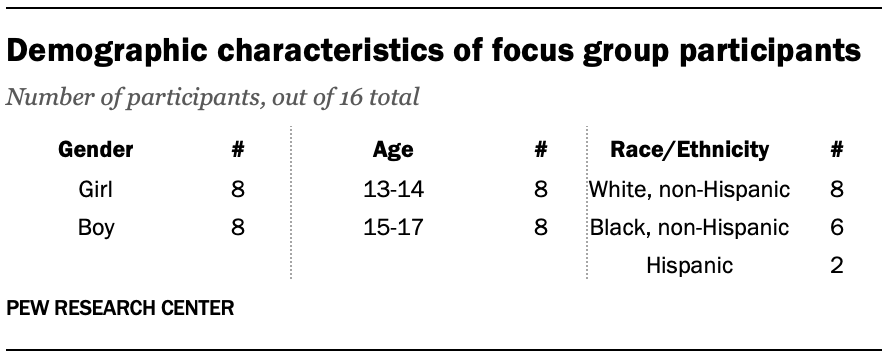Pew Research Center worked with PSB Insights to conduct four live, online focus groups with a total of 16 U.S. 13- to 17-year-olds. The focus groups were conducted online Jan. 12-13, 2022.
The research plan for these focus groups was submitted to an external institutional review board (IRB), Advarra, which is an independent committee of experts that specializes in helping to protect the rights of research participants. The IRB thoroughly vetted this research before recruitment for the focus groups began. Due to the risks associated with doing research with minors, this research underwent a full board review and received approval (Pro00059721).
The focus groups included two groups of eighth graders (ages 13 to 14 years old) lasting 60 minutes and two groups of 10th to 12th graders (ages 15 to 17) lasting 90 minutes. The two groups for each age group were separated by gender (i.e., one group of boys and one of girls for each age group). Each group included four participants and was led by an experienced moderator using a discussion guide developed by Pew Research Center. The focus groups were conducted over a secure, online research platform with video and audio capabilities.
As part of recruitment efforts, the vendor pre-screened parents by phone to gain their consent before screening the teenage research participants. Once eligible participants were identified, their parents confirmed whether they were available for the focus group and both parents and the respondents signed an informed consent form. All participants were paid for their time.
Participants had to meet several criteria to be eligible. First, potential participants had to be living in the United States and meet one of our age group criteria (i.e., 13 to 14 years old and in eighth grade, or 15 to 17 years old and in 10th to 12th grade). Second, participants were screened for their involvement in extracurricular activities to ensure they were accustomed to participating in group activities.10 Third, the group discussions were centered on technology and social media usage, so all respondents were also required to have access to a smartphone and use social media. Fourth, they had to have access to the internet and a device with a working webcam. And finally, participants had to be willing to attend the online focus group on a particular date and time. The vendor used these criteria to identify potential participants for the focus groups. In order to ensure a diverse mix of participants among all who qualified, the research team also collected demographic information such as household income, education level, urbanicity, ethnicity and race. See below for a demographic breakdown of the participants:

The findings of the focus groups are not statistically representative and cannot be extrapolated to wider populations. Instead, these finding provide color, context and clarity to the larger conversation of teens’ views of and experience with social media and helpful insight as researchers development the survey instrument.
Some quotes from these focus groups have been lightly edited for clarity or to remove identifying details.
Moderator guide for 13- to 14-year-olds
- Section 1: Welcome/Ground rules/Introduction
- Section 2: Technology overview
- Section 3: COVID-19 and tech
- Online learning
- Changes in tech use
- Section 4: Social media
- Things teens do on social media
- Attitudes about social media
- Teens and their connections, relationships on social media
- Conflict on social media
- Privacy
- Section 5: Closing
Moderator guide for 15- to 17-year-olds
- Section 1: Welcome/Ground rules/Introduction
- Section 2: Technology overview
- Section 3: COVID-19 and tech
- Online learning
- Changes in tech use
- Section 4: Social media
- Things teens do on social media
- Attitudes about social media
- Teens and their connections, relationships on social media
- Conflict on social media
- Dating and social media
- Online activism
- Cancel culture
- Privacy
- Section 5: Closing




